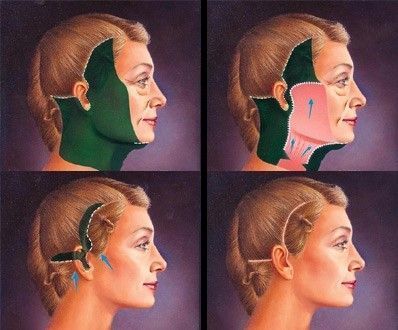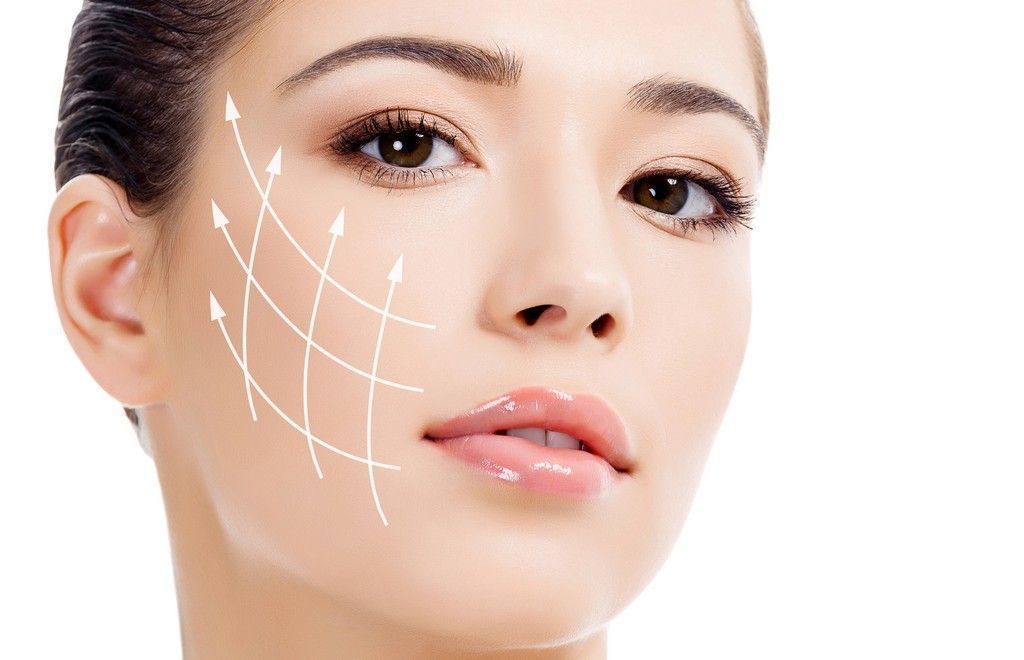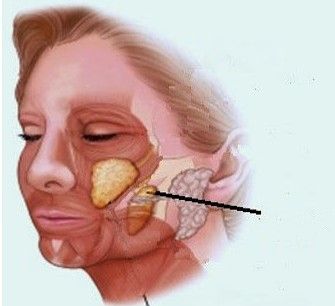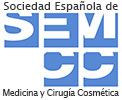Face lifting, facelift or rhytidectomy surgery
Summary of surgery

TIME
3-4h

ANAESTHESIA
General

HOSPITALISATION
1 night

RECOVERY
2 weeks
Face lift video (subtitled in English)
The ageing process is inevitable, and over time, our face begins to show signs of the accumulated years. Skin loses its elasticity, facial muscles weaken and wrinkles, fine lines and sagging can become more evident. Fortunately, a facelift is a widely used cosmetic procedure that can help reverse some of these signs of ageing and restore a more youthful, refreshed appearance to your face. In this article, we’ll explore what a facelift is, who are good candidates, the different types of facelifts, and what to expect from the procedure.
What is a facelift?
A facelift, also known as a rhytidectomy, is a surgical procedure that aims to tighten and firm the skin of the face and neck. This procedure helps to improve the appearance of facial sagging, deep wrinkles and folds. It is often performed to provide a more youthful and revitalised appearance.
Ideal Candidates
Ideal candidates for a facelift are people who have noticeable signs of facial ageing and wish to improve their appearance. Good candidates are generally healthy adults who do not have serious medical conditions and who have realistic expectations about the results of the procedure.
Types of facelift
Traditional facelift:
Involves making incisions in the hairline, around the ears and, in some cases, under the chin. The skin and underlying tissues are then tightened to achieve a tightening effect.
Mini facelift:
A less invasive procedure that focuses on specific areas, such as the jaw and neck, and uses smaller incisions.
Neck lift:
Focuses on correcting sagging in the neck and can be performed independently or in conjunction with a full facelift.

Book a visit
You can do it in 3 ways:
– Free on-site visit: Call +34 932066540 from Monday to Thursday from 9:00 am to 6:00 pm and Friday from 9:00 am to 3:00 pm.
– Free on-site visit with IMMEDIATE booking: For booking outside office hours. We charge 60 € on your card to avoid false bookings. It is refunded on the day you come to the consultation.
– ONLINE Visit: Video conference using whatsapp or Zoom. Cost of 60 € non-refundable. When booking indicate in the comments that you want videoconferencing and not on-site.

Book a visit
You can do it in 3 ways:
– Free on-site visit: Call +34 932066540 from Monday to Thursday from 9:00 am to 6:00 pm and Friday from 9:00 am to 3:00 pm.
– Free on-site visit with IMMEDIATE booking: For booking outside office hours. We charge 60 € on your card to avoid false bookings. It is refunded on the day you come to the consultation.
– ONLINE Visit: Video conference using whatsapp or Zoom. Cost of 60 € non-refundable. When booking indicate in the comments that you want videoconferencing and not on-site.
WHERE DO WE OPERATE?
At Clínica Sanza we rely on the Sagrat Cor Hospital, part of the Quirónsalud group, to perform our surgical procedures.
Its prestige, facilities, medical and healthcare staff, as well as its technology are a guarantee.
BARCELONA: A HEALTH HUB
Do you want to know why it is worth coming to Barcelona for plastic surgery and why so many people come from abroad?
WE ORGANIZE EVERYTHING FOR YOU
Your trip, your flight, your operation, your transfer and your hotel with our support agency. We work with the best travel agencies worldwide.
PATIENT’S PROFILE
People with ageing and lax facial skin.
It is indicated indistinctly in women or men, between 40 and 70 years old, even younger, in which the stigmas of aging are incipient and a quick, simple solution is required and not as bulky as a conventional facelift.
Any patient who feels the need to improve their flaccid facial appearance. The moment signs of skin flaccidity begin to appear, and undesirable wrinkles with falling tissues, and regardless of age or sex. Premature flaccidity due to genetics, weight loss or age.
SURGERY PROCEDURE
This operation consists of making an incision in front of the pinna (ear) in the areas of natural wrinkles to keep it hidden. Depending on the size of the facelift, it can be extended behind the pinna and even inside the hair (in cases where we perform a neck lift). The extent of the incision is determined by the amount of skin and flaccidity present on the face and neck. The incision is hidden in the natural wrinkle areas or inside the hair.
It can be combined with eyelid surgery (Blepharoplasty) or procedures on the forehead (Frontoplasty or Brow Lift).
SMAS (Superficial Muscular Aponeurotic System), Weekend lift or Mini lifting, are very similar surgical techniques. They are differentiated by the height and depth of the incision allowing the separation of the skin to work on the internal areas of the face and neck.
In aesthetic surgery, the incisions are made on the most discreate areas of the face and eyelids, being less noticeable and camouflaged.
SMAS (Superficial Muscular Aponeurotic System) Facial pulling technique
With the SMAS technique, the incision will start at the template hair line advancing downwards, always following the hairline, passing in front of the ear and ending at the back of the auricular area.
After dissecting the skin, we can reposition the malar fat (SMAS), generating a younger face and a wrinkle reduction.
Lastly, we remove the excess skin and stich.
Usually we use two different types of sutures: reabsorption stiches for the internal side and non-reabsorption stiches to bind the skin with an intradermic technique.
We cover with a special bandage to reduce bruising, seroma and edema.
In some occasions, we can also proceed with a submentoplasty. In other words, a plastic intervention of the platysma muscle to improve the neck bands. Which is named as Muscle platysma plication.
Weekend lift surgery or “weekend face lift”
In North America and other countries with so much tradition in cosmetic surgery such as Brazil and Venezuela have coined the term “weekend lift” which encompasses a series of aesthetic-surgical procedures, minimally invasive and ambulatory, which allow to recover from 5 to 20 years of youth of the face and neck in a quick, simple, natural and elegant.
Our technique is milar to the SMAS. However, we use smaller incisions as we do not need the skin as separated to work with, as we get deep into it right away.
The incision line in this procedure does not finalize behind the ear, instead, it ends in front of the ears. We dissect the immediate skin that needs to be improved. This procedure is normally focused on patients that have flaccid skin.
Mini lifting surgery
Mini face lifts have as main goal the improvement of very specific areas where there are signs of aging, such as, the face, forehead or neck.
This procedure is less traumatic and the postoperative process is faster.
In Clínica Sanza we recommend the weekend lift as it has great results and very low postoperative risks.
This procedure provides greater and more natural results.
Clinica Sanza medical team have great experience for all type of procedures, ranging from the simplest of interventions to the most complicated. Our team use the latest technologies, equipment and surgical techniques present now days.
We are here to help, improve and rejuvenate your appearance in the most sophisticated, elegant, safe and natural manner.
DURATION OF SURGERY
- The time of surgery is individualized by each patient, the type of intervention and the extent of it, but on average we can say that a facelift lasts between 2 and 4 hours.
PROTOCOL
Pre-operative
- Assessment of the area to determine the extent of surgery and type of technique required
- Follow specific guidelines determined by the doctor
- CBC and tests on cardiac and respiratory status
Anesthesia
- It is usually performed under general anaesthesia supplemented by local anaesthesia in the area of the incisions
Hospitalization
- In Sanza Clinic we perform innovative and minimally invasive techniques so that the patient can return home the same day, except in special medical conditions or that the patient requires, we leave 1 or 2 days in the hospital.
Post-operative
- Postoperative for the first 24 hours is painless.
- Most stitches will fall out on their own (resorb) if any need to be removed, this is done about 15 days after the operation
- Medication if required
- Compressive bandaging for 1-2 days after surgery
- Inflammation and some bruising may occur.
- The recovery is quick and the patient can return to his normal activities very soon, after 1 or 2 weeks.
- Mandatory check-ups after a few days, a few weeks and a few months, as required
Convalescence
- One week’s rest from light activities
- Two weeks without weight bearing
- Physical exercise can be resumed 3 weeks after surgery and gradually; one month after surgery in the case of strenuous sports
RESULTS
- Elevation of the descended tissues of the face, eliminating or considerably reducing them: Nasolabial folds, tear troughs (dark circles under the eyes) and Jowls
- Marked and stretched neck
- Smooth skin
- Defined cheekbones and jaw angle
- Rejuvenated and improved appearance
- Improved psychological profile and self-esteem of the patient
LEVEL OF DIFFICULTY
- Medium – large operation
RISK LEVEL
All surgical or medical treatments have a certain risk or a possibility of complications during the procedures. However, there is a very low percentage of these and it is highly compensated by the end result.
In whichever case, all medical measures are taken to prevent any complication and reduce the risks to low or none.
- Medium risk of the operation
- Risks inherent to surgery: visible scar, alterations in the hairy area, irregularities
- Risks of any operation: haemorrhage, infection, alteration of healing
BEFORE/AFTER PHOTOS
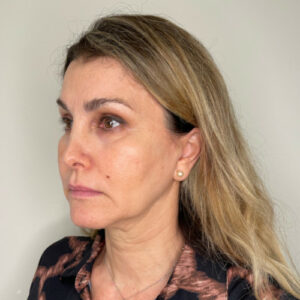
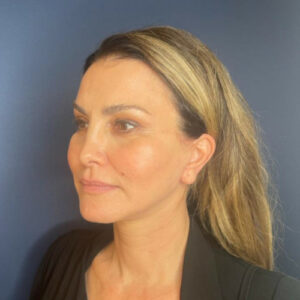
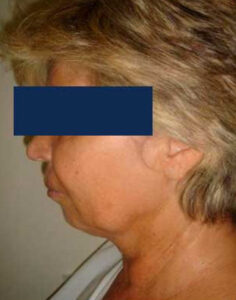
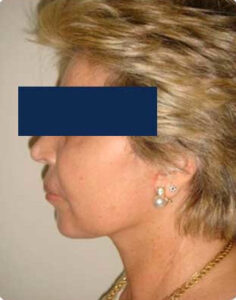
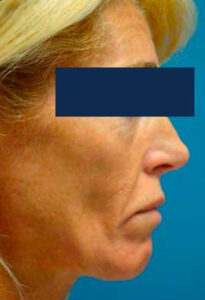
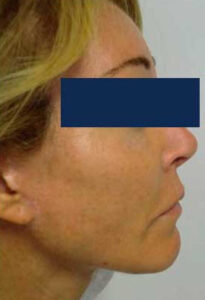
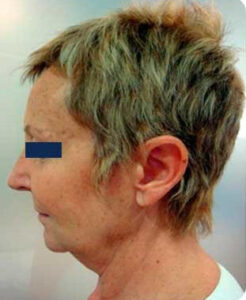
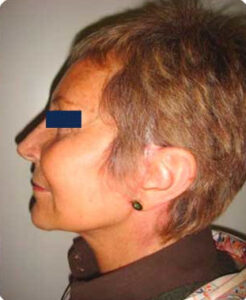
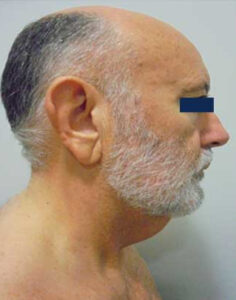
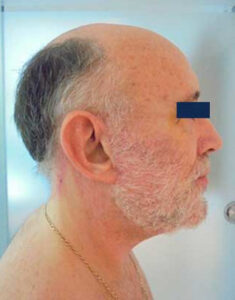
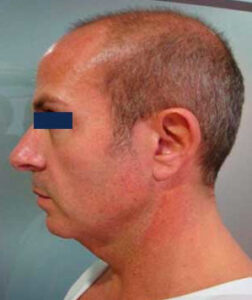
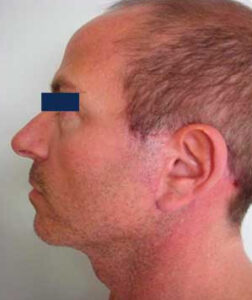
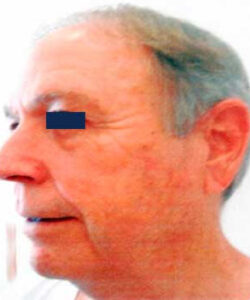
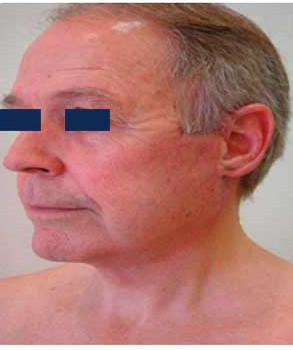
Whatever your case may be, do not hesitate in contacting us.
Clínica Sanza in Barcelona, Spain, quality service
Frequently asked questions about facelift surgery
Does it hurt?
Not at all. It does not hurt. The sensation is of a slight tension behind the ears during the three days following the intervention, which diminishes as the hours go by. Most patients can go outside the day after surgery. Rarely hematomas appear, what usually is a small inflammation that only lasts those three days. To protect against infections, the patient must wear a bandage during the first 24 hours.
What is a weekend lift or facelift?
What are the risks of this surgery?
What are the scars like?
How long do the results last?
Why do people look so stretched or fake?
From what age can we proceed with a facial lifting surgery?
Whenever your skin needs it and you whish to proceed with the intervention.
Normally, these surgical interventions are applied to an age rage of 40 and above. However, in certain circumstances, such as, a great loss of weight, which create flaccidity of the skin, the age can be younger. Also, there are skins that are genetically laxer or have been in excess contact with the sun or other oxidative agents. Thus, creating a breakage of the collagenous molecules, which in turn, generates a premature aging effect of the skin.
In whichever case, the majority of the patients are found in an age range of 40 to 60 years old. However, face lifts can also be appropriate for patients that have an age range between 60 and 80 years old, and still have great results. Always taking into consideration illnesses or contraindicative circumstances.
Are there any problems with a facelift surgery?
The weekend lift for face and neck does not have any contraindication in particular. In reality, it is one of the safest lifting techniques. Its contraindications are exactly the same as any other surgical intervention. With a good preoperative study on behalf of the doctors and the anaesthetist will ensure a safe surgery and determine whether it can be proceeded or not, and in the case of being in good health, age does not matter.




